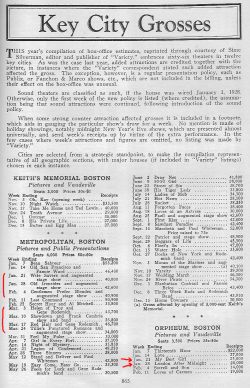Vintage: Theatrical Bookings
Editor's Note: This post was intended to be posted last Thursday but was mistakenly marked as a private post.
The conversation thread in the Vintage post from two weeks ago brought up the question of distribution patterns in the late 1920s, and I thought we'd explore that a little further. Basically, today, every big movie opens wide, which means it appears in theaters nationwide the same day. Even smaller movies with limited releases still get released with more synchronicity than movies ever got 80 years ago.
For the first few decades in cinema history, movies would propagate through the country much more slowly. Sometimes a movie would start with a roadshow tour before the general release, but either way, theaters didn't necessarily snap up new releases right away, and the concept of the "opening weekend" wasn't one that had much focus or value. Contrast this to today, when opening weekend grosses strangely matter more to the industry, the accounting, the prestige, and the media than the final domestic and international totals.

The scans in this post (click to enlarge; in some browsers, click again) list the schedules and revenues of various theaters in Boston and Chicago throughout 1928. I've marked the scheduling of a few sample titles in red. Interestingly, all of them are actually 1927 releases, kept in circulation for up to a year. But note the differences in the dates that different theaters, sometimes within the same city, air the films. My Best Girl, for example, is listed with three different dates, two in January and one in March. And as for London After Midnight...well, I marked that because I want to go back in time to one of those dates and theaters and buy a ticket. London After Midnight is perhaps the single most notorious and missed lost film.
Perhaps more interestingly, look at the diversity of titles. Many of the films listed were not aired in any other theater on these pages. Part of that is because in 1927, almost three times as many films were produced as in 2006. Silents were cheap to make, and theater audiences were larger. Another part of it is that theatrical exhibition was it. If you liked a movie and wanted to see it again, you had to find a theater airing your movie or go without. These days, you just buy the DVD. But in the absence of home video and television, it's not hard to imagine that theaters would still be booking cult favorites like The Princess Bride and Ferris Bueller's Day Off.
There are other fun little things to notice, like the seating capacities and admission prices, both of which are quite different from most theaters today. Keep in mind that these are selected theaters in big cities, so probably these were larger and more expensive than the usual.
Note, too, the comments next to some of the releases, which indicate, for example, that a theater had just debuted a new sound system, or that some particular film was accompanied by a live stage show.
The grosses are interesting in and of themselves. Again, the figures are somewhat skewed by the fact that these are the noteworthy theaters in a couple of big cities, but those revenues are solid even in today's money. If the per-screen average for an average new film on opening weekend is $6000, that's not bad. A typical average per-screen gross of the top ten grossing films of the weekend is maybe $2000.
The figures aren't entirely comparable. One "screen" in modern box office reporting refers to one theater (even if that theater is airing the film on multiple screens). And whereas these scans report grosses for the whole week, modern per-screen averages normally only account for Friday, Saturday, and Sunday (any one of which does more business than Monday through Thursday combined).
Then there is the question of how many showings we're talking about. Today, multiplexes try to cram in as many showings as possible. In the 1920s...I'm not sure. I know some theaters would air only one show a night, but I've also heard of theaters running a film basically nonstop all day long, and people would buy a ticket whenever they liked, watch the movie until the end, and if they came in 10 or 30 or 60 minutes late, they'd stay in their seats for the beginning of the next showing. (Hence the parting expression, "This is where I came in.") But I'm not sure what a typical showtime schedule for 1928 was.
Regardless. If a 1928 theater can charge 50 cents per ticket and drum up similar business as a modern theater charging $10, that tells you something about the demand.
|


